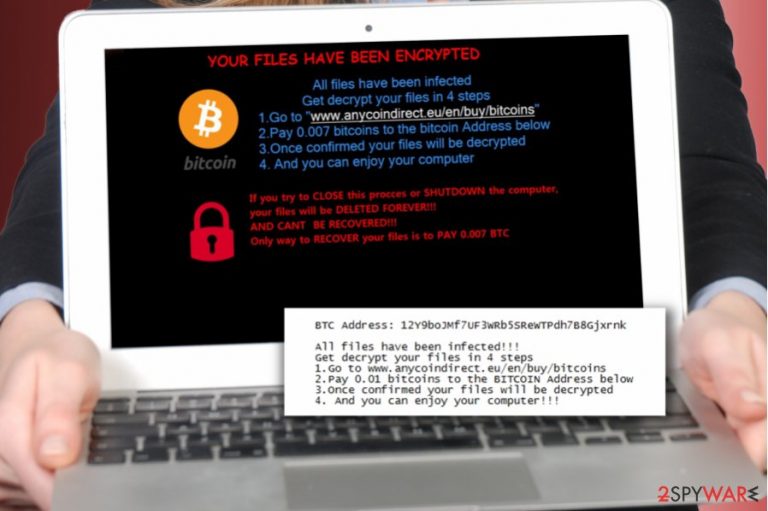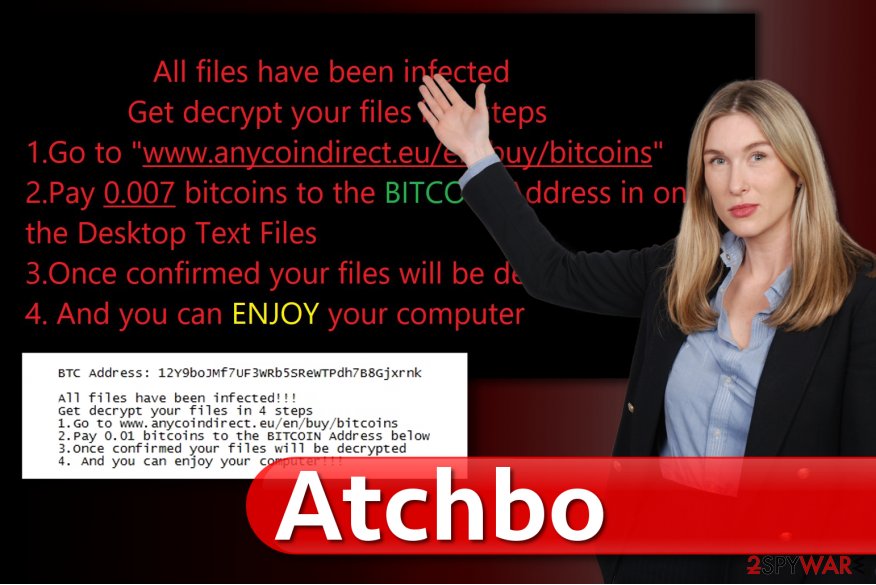Atchbo ransomware / virus (Virus Removal Guide) - Removal Guide
Atchbo virus Removal Guide
What is Atchbo ransomware virus?
Atchbo ransomware is a cyber extortion tool that demands a small ransom

Atchbo ransomware is a highly dangerous computer program created to illegally take victim’s files hostage and demand a ransom.[1] The malicious virus keeps the files encrypted until the victim agrees to pay a defined amount of money to cyber criminals in Bitcoin. An initial analysis of the virus revealed its connection to ExoLock ransomware which was discovered in September 2017.
The malicious virus arrives in Atchbo Ransomware2.0v.exe file which starts scanning the entire computer system and crippling the data using AES or RSA data encryption ciphers.[2] Atchbo virus then displays a message stating that the victim has to pay 0.007 Bitcoin to the provided Bitcoin wallet address.
However, the ransom note left on the desktop, which is called UnlockYourFiles[0-49].txt demands a slightly larger sum of money – 0.01 Bitcoin. The difference of the ransom price in different files left by the virus can strongly confuse the victim.
If we convert the amount of money Atchbo demands in Bitcoins to US dollars, it ranges between 3,34 to 47,65 USD. Comparing to Locky’s or Cerber’s ransom demands, it is quite a small price to pay; however, you shouldn’t do so whatsoever.
There is no reason to waste a single cent paying cybercriminals to unlock your files, so consider removing the ransomware instead and taking proper actions to protect your computer. We strongly recommend using FortectIntego software to remove Atchbo virus ASAP.
Do not react to threats displayed by the ransomware – although it claims that it will delete your files if you shut down your computer, that is not true. Simply reboot the system in Safe Mode with Networking for a successful Atchbo removal. If you have never tried to restart your computer this way, consider using instructions provided below the article.

Prevent the ransom-demanding virus from encrypting your data
Nobody wants to lose their files, memories and work data forever all of a sudden, so it is a must to know how to prevent ransomware infiltration. To prevent ransomware attack, use the provided security tips from Udenvirus.dk team[3]:
- Secure your computer using anti-spyware or anti-malware software;
- Create a data backup – it is a must! Even the most reliable anti-malware programs can be deceived by new and sophisticated malware variants, so data backup is a lifesaver in case your files get encrypted;
- Avoid opening shady emails and especially files attached to them. The same goes for links added to the message body.
Remove Atchbo crypto-ransomware today
To clean up your computer system and make it usable again, remove Atchbo virus immediately. It is a must to protect your system by wiping all malware from it, so consider using a decent anti-malware software.
Manual removal of the ransomware requires special computing skills, so if you are not an IT professional, better do not try to locate virus’ files on your own. Such malicious programs can alter system settings, add or remove Registry keys and perform other modifications that aggravate Atchbo removal.
Getting rid of Atchbo virus. Follow these steps
Manual removal using Safe Mode
Get rid of Atchbo ransomware virus using the following instructions.
Important! →
Manual removal guide might be too complicated for regular computer users. It requires advanced IT knowledge to be performed correctly (if vital system files are removed or damaged, it might result in full Windows compromise), and it also might take hours to complete. Therefore, we highly advise using the automatic method provided above instead.
Step 1. Access Safe Mode with Networking
Manual malware removal should be best performed in the Safe Mode environment.
Windows 7 / Vista / XP
- Click Start > Shutdown > Restart > OK.
- When your computer becomes active, start pressing F8 button (if that does not work, try F2, F12, Del, etc. – it all depends on your motherboard model) multiple times until you see the Advanced Boot Options window.
- Select Safe Mode with Networking from the list.

Windows 10 / Windows 8
- Right-click on Start button and select Settings.

- Scroll down to pick Update & Security.

- On the left side of the window, pick Recovery.
- Now scroll down to find Advanced Startup section.
- Click Restart now.

- Select Troubleshoot.

- Go to Advanced options.

- Select Startup Settings.

- Press Restart.
- Now press 5 or click 5) Enable Safe Mode with Networking.

Step 2. Shut down suspicious processes
Windows Task Manager is a useful tool that shows all the processes running in the background. If malware is running a process, you need to shut it down:
- Press Ctrl + Shift + Esc on your keyboard to open Windows Task Manager.
- Click on More details.

- Scroll down to Background processes section, and look for anything suspicious.
- Right-click and select Open file location.

- Go back to the process, right-click and pick End Task.

- Delete the contents of the malicious folder.
Step 3. Check program Startup
- Press Ctrl + Shift + Esc on your keyboard to open Windows Task Manager.
- Go to Startup tab.
- Right-click on the suspicious program and pick Disable.

Step 4. Delete virus files
Malware-related files can be found in various places within your computer. Here are instructions that could help you find them:
- Type in Disk Cleanup in Windows search and press Enter.

- Select the drive you want to clean (C: is your main drive by default and is likely to be the one that has malicious files in).
- Scroll through the Files to delete list and select the following:
Temporary Internet Files
Downloads
Recycle Bin
Temporary files - Pick Clean up system files.

- You can also look for other malicious files hidden in the following folders (type these entries in Windows Search and press Enter):
%AppData%
%LocalAppData%
%ProgramData%
%WinDir%
After you are finished, reboot the PC in normal mode.
Remove Atchbo using System Restore
-
Step 1: Reboot your computer to Safe Mode with Command Prompt
Windows 7 / Vista / XP- Click Start → Shutdown → Restart → OK.
- When your computer becomes active, start pressing F8 multiple times until you see the Advanced Boot Options window.
-
Select Command Prompt from the list

Windows 10 / Windows 8- Press the Power button at the Windows login screen. Now press and hold Shift, which is on your keyboard, and click Restart..
- Now select Troubleshoot → Advanced options → Startup Settings and finally press Restart.
-
Once your computer becomes active, select Enable Safe Mode with Command Prompt in Startup Settings window.

-
Step 2: Restore your system files and settings
-
Once the Command Prompt window shows up, enter cd restore and click Enter.

-
Now type rstrui.exe and press Enter again..

-
When a new window shows up, click Next and select your restore point that is prior the infiltration of Atchbo. After doing that, click Next.


-
Now click Yes to start system restore.

-
Once the Command Prompt window shows up, enter cd restore and click Enter.
Bonus: Recover your data
Guide which is presented above is supposed to help you remove Atchbo from your computer. To recover your encrypted files, we recommend using a detailed guide prepared by 2-spyware.com security experts.If you do not have a data backup, you can try to fix your files using one of the provided methods:
If your files are encrypted by Atchbo, you can use several methods to restore them:
Delete the ransomware and try Data Recovery Pro
Number 1 tip we want to share is that you MUST remove the ransomware before you attempt to use any data recovery techniques. Therefore, once you remove the ransomware, follow the provided guidelines that explain how to use Data Recovery Pro.
- Download Data Recovery Pro;
- Follow the steps of Data Recovery Setup and install the program on your computer;
- Launch it and scan your computer for files encrypted by Atchbo ransomware;
- Restore them.
Check for Volume Shadow Copies
Volume Shadow Copies come in handy if the virus fails to delete them. Usually, deleting those copies is a part of every ransomware virus' encryption routine as these data copies can help the victim restore the data without paying the ransom. To check whether Volume Shadow Copies are on the system, run ShadowExplorer software.
- Download Shadow Explorer (http://shadowexplorer.com/);
- Follow a Shadow Explorer Setup Wizard and install this application on your computer;
- Launch the program and go through the drop down menu on the top left corner to select the disk of your encrypted data. Check what folders are there;
- Right-click on the folder you want to restore and select “Export”. You can also select where you want it to be stored.
Finally, you should always think about the protection of crypto-ransomwares. In order to protect your computer from Atchbo and other ransomwares, use a reputable anti-spyware, such as FortectIntego, SpyHunter 5Combo Cleaner or Malwarebytes
How to prevent from getting ransomware
Stream videos without limitations, no matter where you are
There are multiple parties that could find out almost anything about you by checking your online activity. While this is highly unlikely, advertisers and tech companies are constantly tracking you online. The first step to privacy should be a secure browser that focuses on tracker reduction to a minimum.
Even if you employ a secure browser, you will not be able to access websites that are restricted due to local government laws or other reasons. In other words, you may not be able to stream Disney+ or US-based Netflix in some countries. To bypass these restrictions, you can employ a powerful Private Internet Access VPN, which provides dedicated servers for torrenting and streaming, not slowing you down in the process.
Data backups are important – recover your lost files
Ransomware is one of the biggest threats to personal data. Once it is executed on a machine, it launches a sophisticated encryption algorithm that locks all your files, although it does not destroy them. The most common misconception is that anti-malware software can return files to their previous states. This is not true, however, and data remains locked after the malicious payload is deleted.
While regular data backups are the only secure method to recover your files after a ransomware attack, tools such as Data Recovery Pro can also be effective and restore at least some of your lost data.
- ^ Abstract Ransomware Annex. UPF. Biblioteca i Informàtica.
- ^ Yimu Hu. A Brief Summary of Encryption Method Used in Widespread Ransomware. InfoSec Insitute. IT Security Training & Resources.
- ^ UdenVirus. UdenVirus. Malware Removal Guidelines.







